Cemeteries serve as perfect wildlife sanctuaries because they offer undisturbed space with mature trees, diverse plantings, and minimal human activity. You’ll find resident birds like woodpeckers and chickadees alongside seasonal migrants using these green havens as rest stops. Their century-old trees provide ideal nesting sites, while monuments create perches and shelter for various species. The unique combination of tranquility, architectural features, and rich vegetation creates urban biodiversity hotspots worth exploring at dawn.
Urban Cemetery Bird Species List
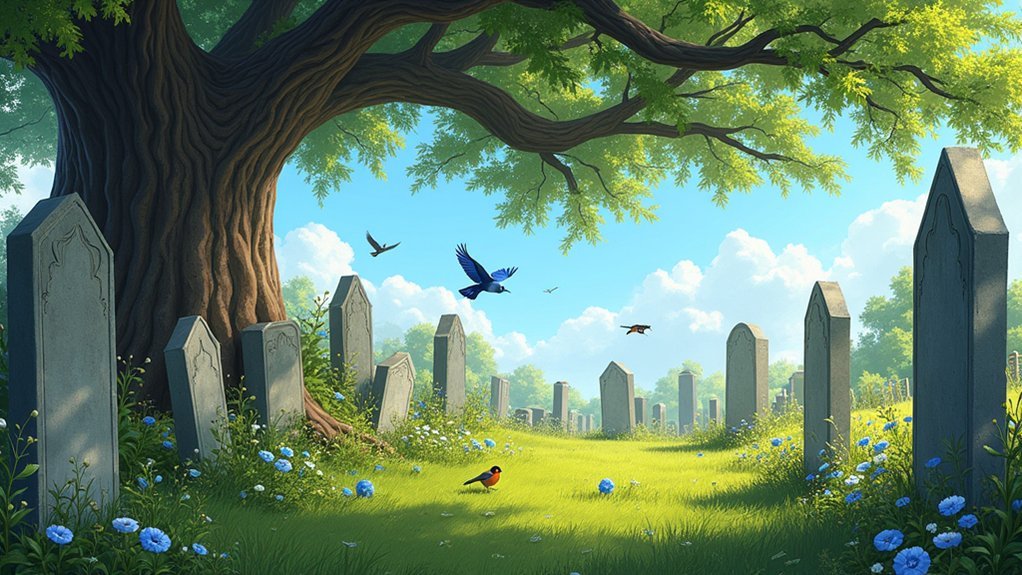
Birdwatchers seeking urban sanctuaries need search no more than local cemeteries, where the Audubon Society recognizes exceptional avian diversity thrives away from city commotion.
You’ll regularly spot woodpeckers, mockingbirds, sparrows, and chickadees among the gravestones, creating a vibrant catalog of flora and fauna worth exploring.
The distinctive green spaces of cemeteries harbor surprising residents like monk parakeets—Brooklyn’s Green-Wood Cemetery inhabitants descended from birds that escaped JFK Airport in the 1960s.
During migration seasons, you might witness impressive flocks of Canadian geese, sometimes numbering 100 strong, resting during their remarkable 1,500-mile journeys.
When the seasons shift, nature’s travelers find solace among the headstones, resting their wings mid-journey.
These peaceful grounds offer birds essential nesting sites and food sources through diverse plantings, supporting both year-round residents and seasonal visitors in otherwise concrete-dominated landscapes.
Common Resident Birds of Historic Burial Grounds
You’ll find that historic cemeteries offer birds perfect architectural advantages with their mature trees, ornate monuments, and wrought-iron fences providing nesting sites and perches beyond what modern urban landscapes typically offer.
Woodpeckers, chickadees, and mockingbirds particularly thrive in these spaces, establishing permanent residence while enjoying the abundant food sources and limited human disturbance.
These burial grounds also serve as critical migration rest stops, where exhausted travelers like Canadian geese can recuperate during their remarkable 1,500-mile journeys before continuing their seasonal travels.
Avian Architectural Advantages
Historic burial grounds serve as unexpected sanctuaries for diverse bird populations, attracting the keen eyes of Audubon Society enthusiasts nationwide.
You’ll notice the cemetery’s natural habitats offer perfect architectural elements for avian residents: towering trees provide nesting sites while ornamental shrubs offer crucial food sources.
Woodpeckers, chickadees, and mockingbirds thrive in these peaceful environments, benefiting from minimal human disturbances. The open layout combined with dense foliage creates ideal hunting grounds and protection from predators.
Even non-native species like monk parakeets have established colonies, adapting to these tranquil spaces. During migration seasons, you’ll spot Canadian geese resting on cemetery grounds during their impressive 1,500-mile daily journeys.
These specialized landscapes unintentionally serve as masterfully designed bird habitats, with their varied vegetation heights and abundant resources supporting year-round avian communities.
Migration Rest Stops
As wind currents shift seasonally, cemeteries transform into essential rest stops along avian migratory routes, offering exhausted travelers a peaceful sanctuary amid urban landscapes.
When you visit burial grounds, you’ll witness Canadian geese resting during their impressive 1,500-mile journeys, often traveling in flocks of up to 100 birds.
These sacred spaces provide vital resources that migrating birds desperately need:
- Undisturbed areas where birds can recuperate without human interference
- Diverse flora offering nutritional sustenance for energy-depleted travelers
- Protected habitat islands within concrete jungles that serve as navigational landmarks
The Audubon Society specifically recognizes these burial grounds as prime birdwatching locations.
Even non-native species like Monk parakeets have established permanent communities in cemeteries like Green-Wood, demonstrating these spaces’ unique capacity to support avian life in otherwise inhospitable urban environments.
Seasonal Migrants: When and Where to Spot Them
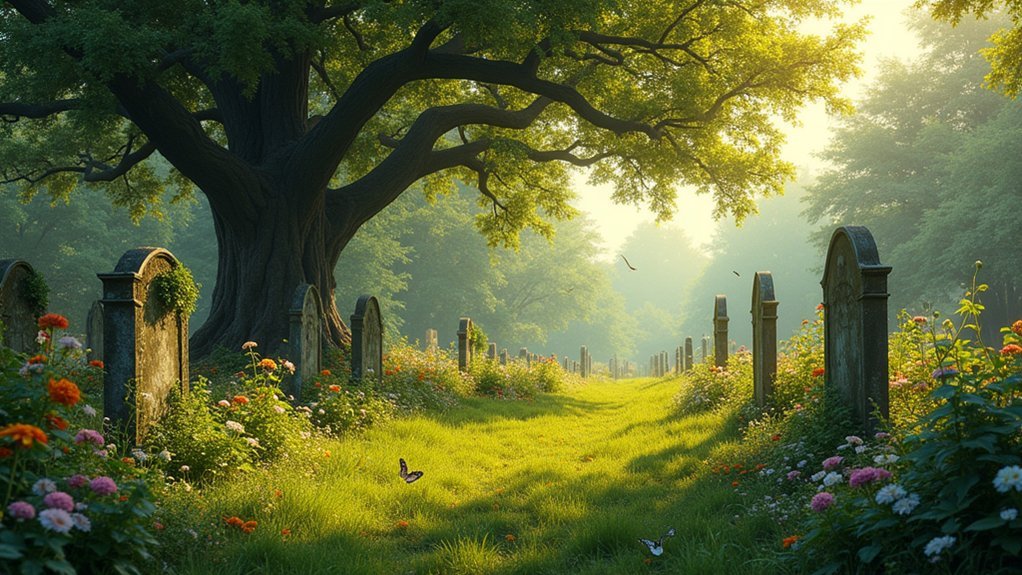
You’ll find spring migration transforms urban cemeteries into bustling wildlife highways as Canadian geese travel in flocks up to 100 strong, covering an impressive 1,500 miles in just 24 hours.
Winter months reveal surprising seasonal patterns when foxes increase their hunting activity, targeting migratory species seeking shelter among the tombstones and vegetation.
The Audubon Society recognizes these sacred grounds as prime spots to witness both the spectacular spring arrivals and the formation of winter roosts among the peaceful cemetery landscapes.
Spring Migration Routes
While cities buzz with human activity, cemeteries transform into vibrant wildlife corridors during spring migration season. From February to June, these peaceful grounds become vital waypoints for migrating birds traveling remarkable distances—some Canadian geese covering up to 1,500 miles in just 24 hours.
Cemetery managers increasingly recognize their grounds’ ecological importance along major migration routes. These green oases offer three essential resources:
- Safe resting zones where exhausted travelers can recover between flights
- Abundant insect populations and nectar sources unavailable in concrete landscapes
- Reduced human disturbance compared to busy urban parks
You’ll notice different species arriving in waves as spring progresses, each following ancient flyways that have adapted to our modern cityscapes.
Cemeteries provide significant stepping stones for these winged travelers maneuvering through urban environments.
Winter Roosts Revealed
When winter’s grip tightens on urban landscapes, cemeteries transform into essential sanctuary spaces for countless migratory birds seeking shelter from harsh conditions.
You’ll find these winter roosts provide significant protection, allowing birds to conserve energy during the coldest months.
Visit Green-Wood Cemetery and you’re likely to spot woodpeckers drilling into aged trees or sparrows darting between gravestones.
The cemetery’s diverse habitat—with its mature trees and natural features—creates ideal roosting and foraging opportunities for seasonal visitors.
Watch for Canadian geese making stopovers during their extensive migrations, using these peaceful grounds as important rest areas.
By supporting cemetery conservation efforts, you’re helping preserve these unexpected wildlife havens.
Next time you’re near a cemetery in winter, bring binoculars—you’ll be surprised by the vibrant bird life seeking refuge there.
Rare Sightings and Notable Cemetery Visitors
Beneath the solemn stones and peaceful pathways of cemeteries, extraordinary wildlife encounters await the observant visitor. You might spot the newly discovered Agrilus sp. 9895 beetle at Green-Wood Cemetery, with its distinctive male genitalia and sex-specific coloration—evidence of rare wildlife thriving in these urban sanctuaries.
- Monk parakeets with brilliant green plumage nesting in the cemetery’s trees, descendants of birds that escaped JFK Airport in the 1960s.
- Uniquely coiffed squirrels darting between gravestones, including the exceptionally rare albino variety (1 in 10,000 odds).
- Fox families making their dens beneath century-old monuments, as observed at Laurel Hill Cemetery.
These protected spaces don’t just harbor common species—they’re havens for rare plants and animals that find few other refuges in urban landscapes.
Dawn Chorus: Best Times for Cemetery Birding
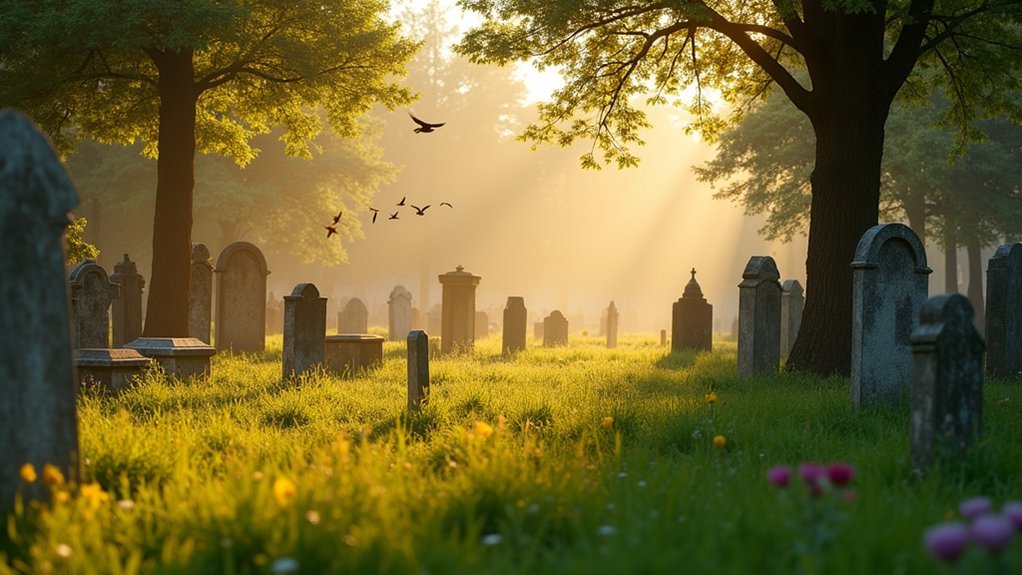
The enchanted dawn hours transform cemetery grounds into nature’s most magnificent concert halls. You’ll experience the full splendor of the dawn chorus when you arrive early, as birds begin their melodic performances in these tranquil urban areas. While cities wake with traffic noise, cemeteries offer quiet sanctuaries where birdwatching enthusiasts can clearly hear woodpeckers, mockingbirds, and chickadees.
| Season | Best Time | Common Birds | Activity Level |
|---|---|---|---|
| Spring | 5-7 AM | Mockingbirds | Highest |
| Summer | 4:30-6 AM | Woodpeckers | Very Active |
| Fall | 6-8 AM | Sparrows | Moderate |
| Winter | 7-9 AM | Chickadees | Mild |
These green oases attract diverse species, including migratory birds like Canadian geese that travel up to 1,500 miles daily, making cemeteries essential biodiversity hotspots recognized by the Audubon Society.
Nesting Habits and Breeding Behavior in Cemetery Trees
Centuries-old trees in cemetery grounds offer ideal nesting sites that you won’t find in many urban environments.
The tranquil setting with minimal human disturbance creates perfect conditions for wildlife to establish their breeding territories. You’ll notice various bird species taking advantage of these nesting habitats, particularly woodpeckers, owls, and sparrows that thrive in the quiet sanctuary.
Cemetery trees provide valuable breeding resources:
- Mature oaks and maples with natural cavities that serve as protected nurseries for raising young
- Diverse tree species offering varied nesting options to accommodate different wildlife preferences
- Undisturbed canopies where birds can build nests away from predators and human interference
These green havens support vital breeding cycles while the surrounding floral patches attract pollinators and provide essential food sources for nesting wildlife.
Cemetery Bird Watching Etiquette and Guidelines
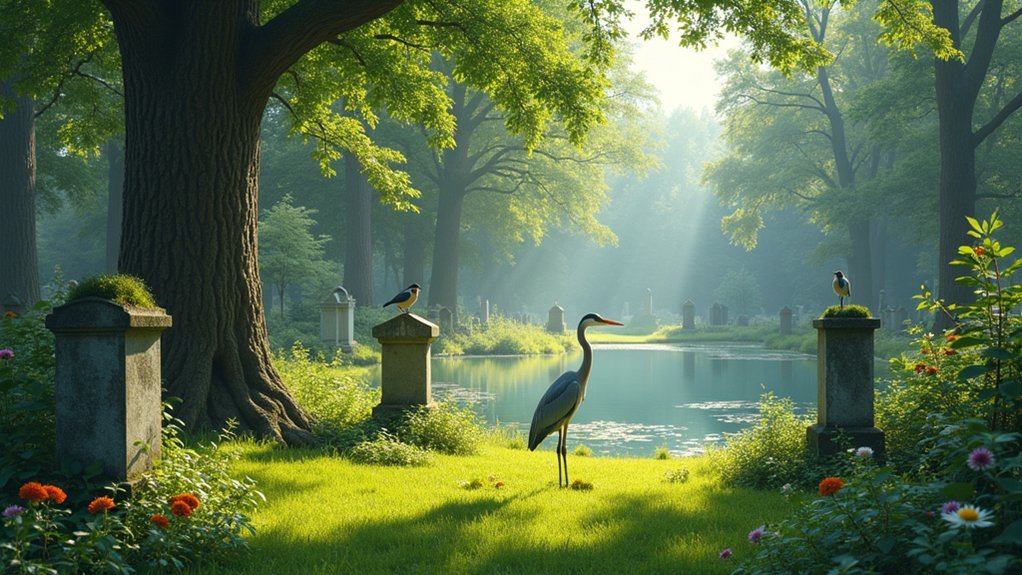
When visiting cemeteries for bird watching, you’ll need to balance your enthusiasm for wildlife with respect for these sacred spaces. Cemetery since these locations serve dual purposes, your behavior should reflect awareness of both nature and remembrance.
Keep noise to a minimum, walking quietly along pathways and speaking in hushed tones. This won’t just help others who may be visiting loved ones—it’ll improve your bird watching experience too.
Quiet observation honors both the grieving and the birds you hope to glimpse.
Time your visits for early morning or late afternoon when birds are most active. Maintain a respectful distance from graves and any funeral proceedings you might encounter.
Remember to stay away from nesting areas to avoid distressing birds.
With thoughtful consideration, you’ll contribute to preserving these unique sanctuaries where wildlife and remembrance coexist harmoniously.
Frequently Asked Questions
Are Cemeteries Good for the Environment?
Yes, cemeteries are excellent for the environment. You’ll find they conserve urban green spaces, support diverse wildlife, protect bee populations, provide bird habitats, and maintain ecological balance through their minimal disturbance and natural management practices.
What Is the Spiritual Significance of a Cemetery?
Cemeteries hold spiritual significance as places where you’ll encounter the veil between worlds. They’re sacred grounds for honoring ancestors, reflecting on mortality, and finding peace in the connection between life, death, and memory.
Were Cemeteries Used as Parks?
Yes, you’d definitely recognize early rural cemeteries like Mount Auburn and Green-Wood as parks. They were deliberately designed as beautiful recreational spaces where you could enjoy nature, art, and monuments while visiting the deceased.
What Are the Benefits of Visiting Graveyards?
You’ll find numerous benefits when visiting graveyards. You can experience urban wildlife, observe rare birds and bees, enjoy peaceful green spaces, and improve your mental wellbeing while exploring historical sites and connecting with nature.
In Summary
Cemeteries offer birds and wildlife what they need most: undisturbed green spaces in our concrete jungles. You’ll find these peaceful sanctuaries provide perfect habitat with their mature trees, diverse plantings, and minimal human activity. As you’ve seen from the various species that call these grounds home, your local cemetery isn’t just a place of remembrance—it’s a thriving ecosystem. Next time you visit, don’t forget your binoculars!

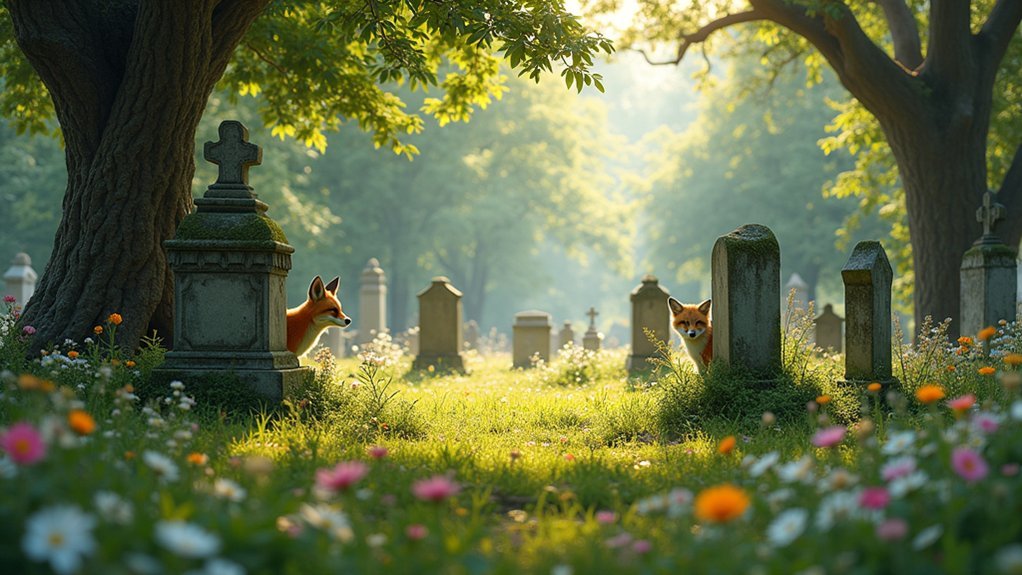



Leave a Reply